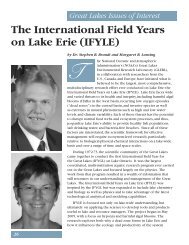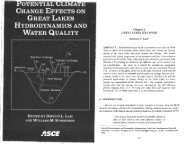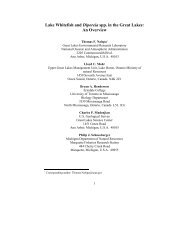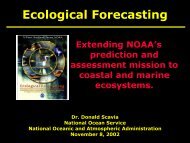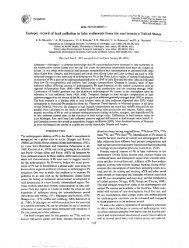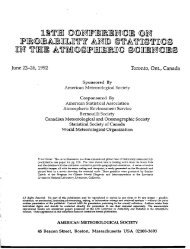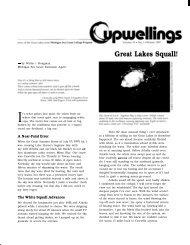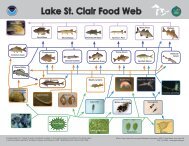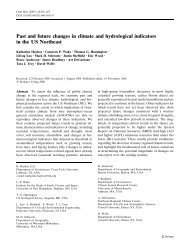Phosphorus limitation and diel control of nitrogen-fixing ...
Phosphorus limitation and diel control of nitrogen-fixing ...
Phosphorus limitation and diel control of nitrogen-fixing ...
You also want an ePaper? Increase the reach of your titles
YUMPU automatically turns print PDFs into web optimized ePapers that Google loves.
48<br />
Mar Ecol Prog Ser 345: 41–50, 2007<br />
0900<br />
A<br />
0630<br />
B<br />
1200<br />
0930<br />
1500<br />
1230<br />
1800<br />
1530<br />
2100<br />
1830<br />
2200<br />
2130<br />
2300<br />
2230<br />
day than reported by Gallon et al. (2002). These differences<br />
may partially reflect cloudiness during the days <strong>of</strong><br />
measurement. N 2 fixation continued throughout the dark<br />
period, as reported in other studies <strong>of</strong> the Baltic Sea in<br />
which the dominating genus was mostly Aphanizomenon<br />
(Vuorio et al. 1978, Stal & Walsby 1998, Evans<br />
et al. 2000, Gallon et al. 2002). Nodularia spumigena <strong>and</strong><br />
Aphanizomenon sp. fixed N 2 in the dark at 68 to 97%<br />
<strong>and</strong> 31 to 33% <strong>of</strong> maximum rates in light, respectively<br />
(Evans et al. 2000). In this study, the N 2 fixation rates for<br />
N. spumigena culture were slightly lower, 21 to 45% <strong>of</strong><br />
maximum rates in the light. In field samples, dark<br />
fixation rates ranged from 26 to 61% <strong>of</strong> maximum rates<br />
in the light. These rates are higher than is typical <strong>of</strong><br />
heterocystous cyanobacteria. In identical culture experiments,<br />
<strong>and</strong> under a 15:9 h light:dark cycle, N 2 fixation in<br />
the heterocystous cyanobacteria Anabaena aphanizomenoides<br />
<strong>and</strong> Anabaenopsis sp. isolated from the<br />
Neuse River Estuary was significantly more reduced in<br />
the dark (data not shown). In the N. spumigena cultures<br />
from this study, CO 2 <strong>and</strong> N 2 fixation continued at more or<br />
less constant rates during the light period, exhibiting no<br />
lag periods or exhaustion <strong>of</strong> resources for either process.<br />
Nodularia spumigena may be able to store energy in the<br />
form <strong>of</strong> carbohydrates more effectively than other<br />
heterocystous cyanobacteria, allowing it to continue N 2<br />
fixation at high rates throughout the dark period (Evans<br />
et al. 2000). Alternatively, it may be able to utilize other<br />
mechanisms for energy generation in the dark.<br />
Nitrogen fixation rates at the anchor station at 8 m<br />
depth were 45 to 105% <strong>of</strong> the rates in the surface<br />
water, <strong>and</strong> were detectable throughout the night.<br />
Interestingly, the <strong>diel</strong> pattern at 8 m depth was still<br />
present even though irradiance at this depth was only<br />
2 to 4% <strong>of</strong> the surface irradiance, varying between<br />
0.3 <strong>and</strong> 61 µmol m –2 s –1 during the day (06:00 to<br />
23:00 h) (Fig. 5A). Aphanizomenon sp. was present<br />
0000<br />
2330<br />
0100<br />
0030<br />
Fig. 6. Immunoblots from <strong>diel</strong> experiments in the Baltic Sea. (A) 15–16 July 2003,<br />
Cubitainer sampling, <strong>control</strong> treatment (water sampled 14 July 2003) (Expt 03A);<br />
(B) 24–25 July 2003, rosette sampling from 8 m depth (Expt An03). Av1: di<strong>nitrogen</strong>ase<br />
(MoFe protein) from Azotobacter vinel<strong>and</strong>ii; Av2: di<strong>nitrogen</strong>ase<br />
reductase (Fe protein) from A. vinel<strong>and</strong>ii. Sampling times (h) are shown at the<br />
top <strong>of</strong> each lane. Black bar indicates the dark period<br />
0200<br />
0130<br />
0300<br />
0230<br />
0400<br />
0330<br />
0500<br />
0430<br />
at this station, whereas Nodularia<br />
spumigena was not detected in microscopic<br />
observations. The peak in<br />
<strong>nitrogen</strong>ase activity lagged behind<br />
the peak in irradiance intensity at the<br />
anchor station, providing evidence for<br />
light dependence <strong>of</strong> N 2 fixation in<br />
Aphanizomenon sp. The anchor station<br />
experiment demonstrated the<br />
ability <strong>of</strong> natural populations <strong>of</strong><br />
Aphanizomenon sp. to continue to fix<br />
N 2 at a constant rate long after irradiance<br />
levels are drastically reduced,<br />
indicating a reliance on carbohydrate<br />
stores generated during the day.<br />
In both the field samples (including<br />
the anchor station at which Aphanizomenon<br />
sp. was the only diazotroph<br />
detected) <strong>and</strong> Nodularia spumigena cultures, di<strong>nitrogen</strong>ase<br />
reductase (Fe protein) <strong>and</strong> di<strong>nitrogen</strong>ase<br />
(MoFe protein) (N. spumigena cultures only) remained<br />
present throughout the <strong>diel</strong> cycle, <strong>and</strong> no apparent or<br />
consistent changes in intensities or MW were<br />
observed. These results contrast those <strong>of</strong> another Baltic<br />
Sea study, in which a reduction in the Fe protein intensity<br />
was reported during the night (Gallon et al. 2002).<br />
Some diazotrophs, including some cyanobacteria, regulate<br />
<strong>nitrogen</strong>ase activity in response to environmental<br />
factors such as NH + 4 or darkness through structural<br />
modifications <strong>of</strong> the Fe protein (Ludden & Burris 1978,<br />
Zehr et al. 1993, Nordlund 2000). This modification<br />
<strong>of</strong>ten occurs through ADP-ribosylation <strong>and</strong> appears as<br />
a slower migrating, inactive form <strong>of</strong> the Fe protein in<br />
SDS-PAGE. The lack <strong>of</strong> change in motility <strong>of</strong> the <strong>nitrogen</strong>ase<br />
proteins during reduced N 2 -fixation activities<br />
in the dark suggests that Baltic Sea N. spumigena <strong>and</strong><br />
Aphanizomenon sp. do not use size modification as a<br />
mechanism to regulate their <strong>nitrogen</strong>ase activity in<br />
response to darkness, or that the modification is too<br />
labile to be detected. The absence <strong>of</strong> this mechanism in<br />
these heterocystous cyanobacteria is supported by a<br />
prior study with Anabaena variabilis in which the ribosylation<br />
pathway enzymes were not found to be functional<br />
<strong>and</strong> a secondary b<strong>and</strong> was not present (Durner<br />
et al. 1994). Furthermore, ADP ribosylation has not<br />
been found in all non-cyanobacterial diazotrophs studied.<br />
For example, no size modification <strong>of</strong> the Fe protein<br />
was observed for Rhodobacter sphaeroides in response<br />
to either NH + 4 or darkness (Yoch et al. 1988).<br />
Most environmental <strong>nitrogen</strong>ase enzyme studies<br />
have focused on the Fe protein, while the MoFe<br />
protein has received considerably less attention. In this<br />
study, we obtained novel information on the MoFe<br />
protein <strong>of</strong> Nodularia spumigena. Structure <strong>of</strong> the Fe<br />
protein is relatively conserved among diazotrophs as<br />
0600<br />
0630<br />
Av1<br />
Av1<br />
Av2<br />
Av2



